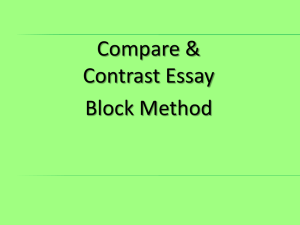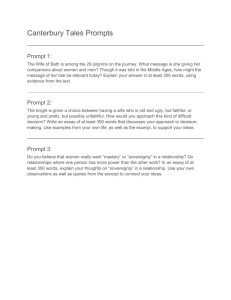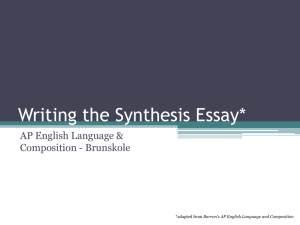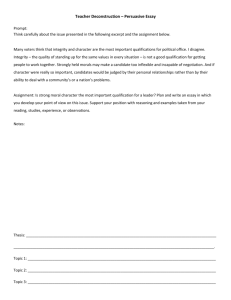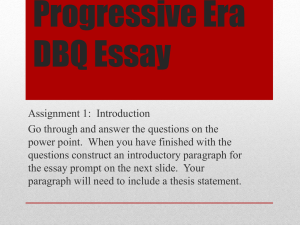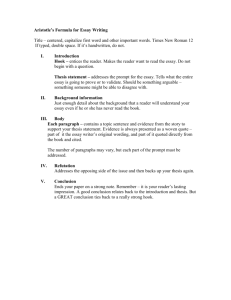Tips for Writing the Synthesis Essay
advertisement
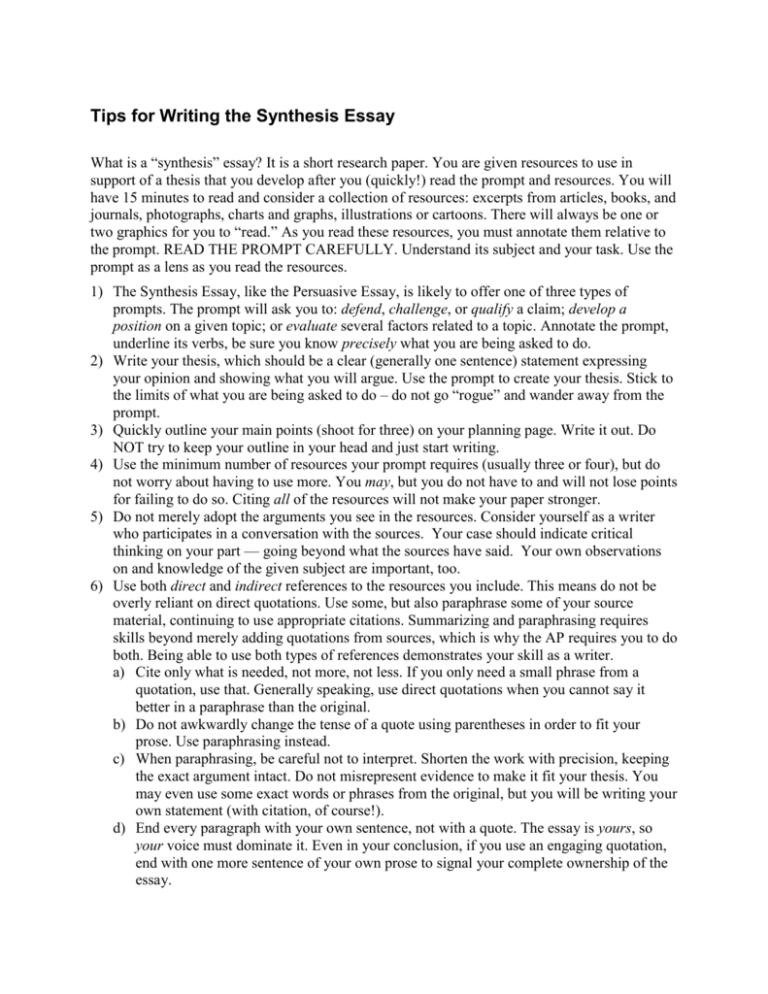
Tips for Writing the Synthesis Essay What is a “synthesis” essay? It is a short research paper. You are given resources to use in support of a thesis that you develop after you (quickly!) read the prompt and resources. You will have 15 minutes to read and consider a collection of resources: excerpts from articles, books, and journals, photographs, charts and graphs, illustrations or cartoons. There will always be one or two graphics for you to “read.” As you read these resources, you must annotate them relative to the prompt. READ THE PROMPT CAREFULLY. Understand its subject and your task. Use the prompt as a lens as you read the resources. 1) The Synthesis Essay, like the Persuasive Essay, is likely to offer one of three types of prompts. The prompt will ask you to: defend, challenge, or qualify a claim; develop a position on a given topic; or evaluate several factors related to a topic. Annotate the prompt, underline its verbs, be sure you know precisely what you are being asked to do. 2) Write your thesis, which should be a clear (generally one sentence) statement expressing your opinion and showing what you will argue. Use the prompt to create your thesis. Stick to the limits of what you are being asked to do – do not go “rogue” and wander away from the prompt. 3) Quickly outline your main points (shoot for three) on your planning page. Write it out. Do NOT try to keep your outline in your head and just start writing. 4) Use the minimum number of resources your prompt requires (usually three or four), but do not worry about having to use more. You may, but you do not have to and will not lose points for failing to do so. Citing all of the resources will not make your paper stronger. 5) Do not merely adopt the arguments you see in the resources. Consider yourself as a writer who participates in a conversation with the sources. Your case should indicate critical thinking on your part — going beyond what the sources have said. Your own observations on and knowledge of the given subject are important, too. 6) Use both direct and indirect references to the resources you include. This means do not be overly reliant on direct quotations. Use some, but also paraphrase some of your source material, continuing to use appropriate citations. Summarizing and paraphrasing requires skills beyond merely adding quotations from sources, which is why the AP requires you to do both. Being able to use both types of references demonstrates your skill as a writer. a) Cite only what is needed, not more, not less. If you only need a small phrase from a quotation, use that. Generally speaking, use direct quotations when you cannot say it better in a paraphrase than the original. b) Do not awkwardly change the tense of a quote using parentheses in order to fit your prose. Use paraphrasing instead. c) When paraphrasing, be careful not to interpret. Shorten the work with precision, keeping the exact argument intact. Do not misrepresent evidence to make it fit your thesis. You may even use some exact words or phrases from the original, but you will be writing your own statement (with citation, of course!). d) End every paragraph with your own sentence, not with a quote. The essay is yours, so your voice must dominate it. Even in your conclusion, if you use an engaging quotation, end with one more sentence of your own prose to signal your complete ownership of the essay. Incorporating and Citing Materials from Your Sources • Use signal phrases to introduce your sources, ideally identifying them by name and title, such as: As UCLA researcher Lori Smith suggests…; According to Sam Jones, director of the College Testing Board, …; and then cite the source at the end by its letter in parentheses. Examples: Therefore, it is unfair to blame the increase in childhood obesity on soft drink consumption. As Kristen Powers of the Grocery Manufactures of America points out, “The rise in obesity is the result of many complex factors affecting eating and activity behaviors, and there are no simple solutions” (Source C). In “The Demise of Dailies: An Honest Look” Sanders says that the availability of newspapers online helps “democratize society because anyone with internet can access not only the local paper, but also national and international papers” (Source D). As found in a study by the University of Ottawa, countries that embrace animal rights tend to have less crime overall (Source A). • Avoid saying: As Source C suggests… or As shown in Source B…. While it is technically accurate, it is unsophisticated. In most cases, you will be able to cite the resource either by its author or its source (see examples above), and save the “Source A, Source B” stuff for your parenthetical citations. • Provide analysis of your evidence: What does this quotation demonstrate, reveal, or suggest regarding your thesis? For body paragraphs, generally do the following: – open with a claim directly related to your thesis – use source materials to support it, using signal phrases, argument verbs, and parenthetical citations (Source A, Source B, etc.) – provide analysis of the quotation/paraphrase relative to your claim – link the material back to your thesis. Citation/Argument Verbs Here are a few verbs you might use to introduce or follow quotations and paraphrases: argues reveals claims emphasizes underscores indicates points out suggests recommends advises proposes concludes asserts speculates implies believes

